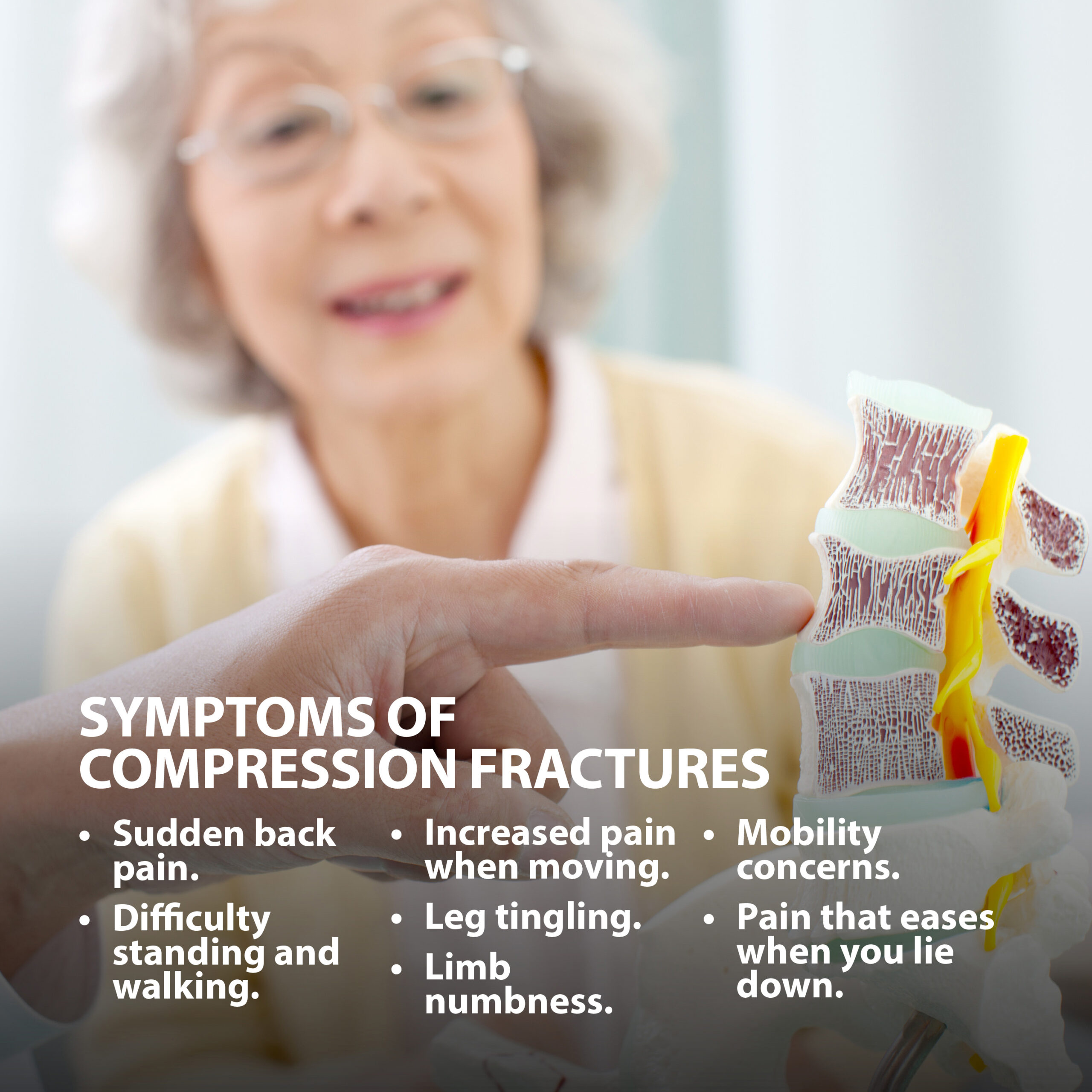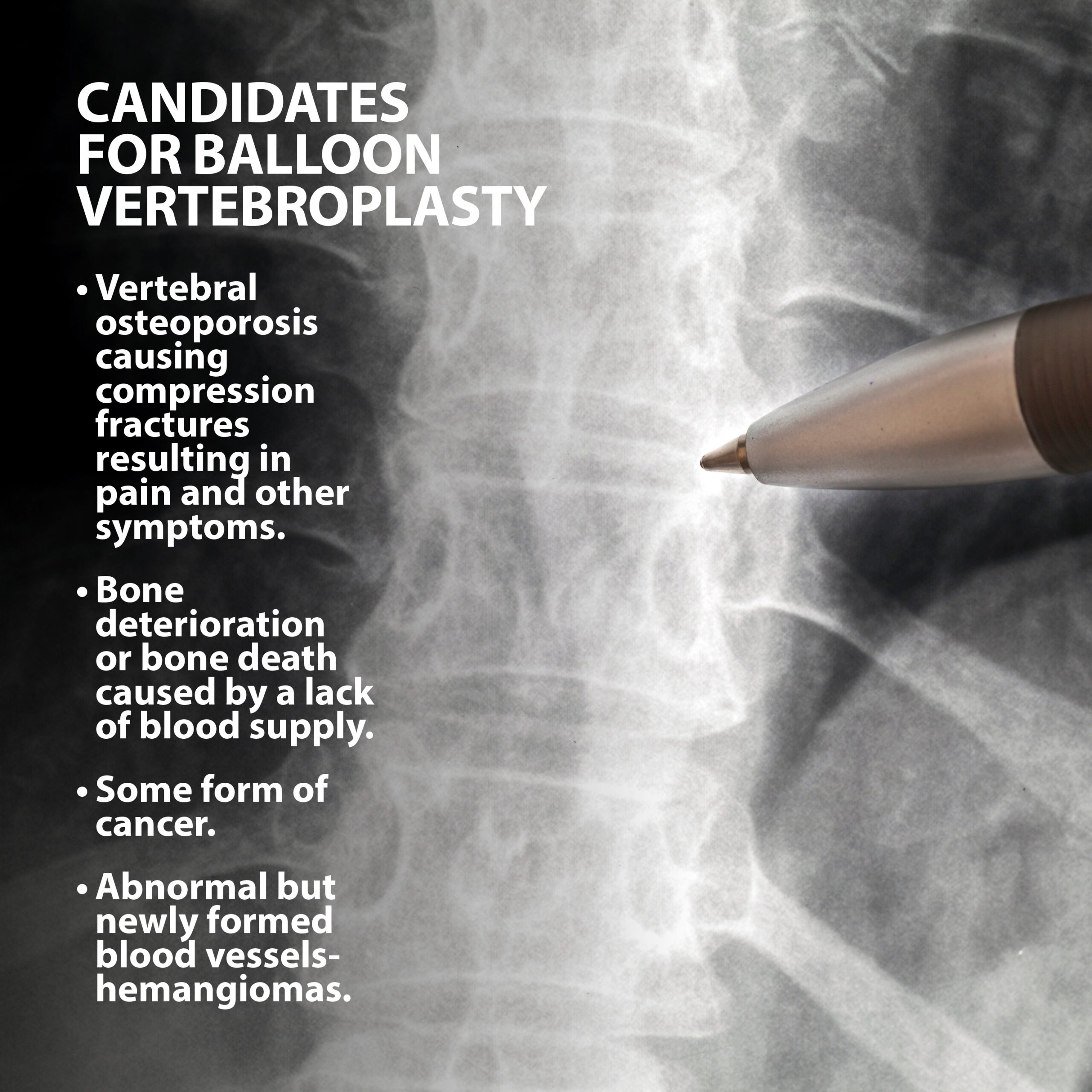Kyphoplasty (Balloon Vertebroplasty)
Overview
The spine is the most important physical component inside your body. It provides the structural framework enabling you to stand, move, and perform any other type of action. The spine comprises many essential nerves that control life-sustaining functions like breathing and bowel and bladder control.
Even the most minor spinal injuries could have serious consequences. Particularly concerning issues include vertebral fractures. Fortunately, these can be fixed through a surgical procedure that restores damaged vertebrae. This procedure is known as kyphoplasty or balloon vertebroplasty.
Anatomy
Your backbone is made up of many small, bone-like structures called vertebra. The backbone provides the passageway for which your spinal cord forms and extends.

Description
Over time, vertebrae can weaken. Should they weaken significantly, you stand at an increased risk of developing cracks which are medically referred to as vertebral compression fractures.
Causes
Compression fractures often occur because of long-standing bone-weakening diseases like osteoporosis. Such injuries might also occur following immediate traumatic events, such as car accidents, forceful physical contact, or severe falls. Researchers have found that moderate to severe osteoporosis is typically the underlying cause impacting roughly 750,000 individuals each year.
Cancerous tumors are another underlying factor. Some cancers spread to the back and spinal regions. As these illnesses progress, they can inflict vertebral damage, eventually leading to fractures.
Risk Factors
The most significant risk factors are gender and age. For example, women are more likely to develop vertebral compression fractures than men. Up to 40 percent of women over 80 are thought to encounter this type of injury at some point.
Age increases one’s chances significantly. As you grow older, your bones naturally grow weaker, which can increase your chance of developing compression fractures. The risk for osteoporosis also increases with age.
Symptoms
In many instances, the most noticeable symptom is sudden back pain. Pain may be accompanied by:
- Difficulty standing and walking.
- Increased level of pain when engaging in movement.
- Pain eases when you lie down.
- Limb numbness.
- Leg tingling.
- Mobility concerns.
In severe cases or as the condition progresses, you might experience a loss of height.

Complications
If not addressed as soon as possible, compression fractures can result in spinal deformity, which might interfere with your ability to stand up straight or perform even the slightest physical activity. Fractured bone structures can also press on spinal nerves. This can eventually result in significant nerve damage and associated disability.
Diagnosis
Your doctor starts to reach a diagnosis by performing a thorough physical examination by documenting your medical history and executing a visual evaluation.
Diagnosis is often confirmed using diagnostic imaging tools, such as:
- Magnetic Resonance Imaging: An MRI allows doctors to capture 3-D images of your back and spine to identify any abnormalities.
- X-rays are internal images that enable doctors to identify problems like bone alignment problems and disk deterioration.
- Computerized Tomography: A CT or CAT scan uses images to reveal the spinal cord’s shape and size.
- Bone Densitometry: This evaluation measures bone density, often a benchmark statistic that confirms osteoporosis’s presence.
Balloon Vertebroplasty
Balloon vertebroplasty has been used to treat compression fractures since the early 1990s. This procedure is considered minimally invasive, taking only one or two hours to complete. Often it can be performed on an outpatient basis or only needs one night in the hospital.
The Process
Once a patient is administered either local anesthesia, intravenous or general sedation, your orthopedic surgeon uses an X-ray to guide a balloon equipped with acrylic cement. This powerful binding material is injected into the fractured vertebrae to fix and stabilize the injured backbone.
Who Is A Candidate For Balloon Vertebroplasty?
This procedure may be right for you if you meet the following criteria:
- You have been diagnosed with vertebral osteoporosis causing compression fractures resulting in pain and other symptoms.
- The problem has led to bone deterioration or bone death caused by a lack of blood supply.
- You have been diagnosed with some form of cancer.
- You have the presence of abnormal but newly formed blood vessels referred to as hemangiomas.

This procedure is not advised if you have:
- A compression fracture that has responded favorably to other treatments
- Curvature of the spine.
- Spinal compression that is not caused by compression fractures.
- Infections.
- Blood clotting disorders.
- A compression fracture for one year or longer.
The procedure is well-tolerated. Complications only occur in less than two percent of surgeries on simple compression fractures. The risk for complications is slightly higher if your surgery corrects fractures brought on by cancerous tumors.
Recovery
Recovery is usually not a long or complicated undertaking. You might notice pain relief in as little as a couple of days following surgery. It is advised not to partake in any strenuous activity or lift heavy objects for at least six weeks.
Next Steps
Contact your Florida Orthopaedic Institute physician to learn more about kyphoplasty.
Areas of Focus
- Spine
- Anterior Cervical Corpectomy & Discectomy
- Artificial Disk Replacement (ADR)
- Bone Cement Injection
- Degenerative Disk Disease
- Diffuse Idiopathic Skeletal Hyperostosis (DISH)
- Discectomy
- Discitis Treatment & Information
- Epidural Injections for Spinal Pain
- Foraminotomy
- Interlaminar Implants
- Interlaminar Lumbar Instrumental Fusion: ILIF
- Kyphoplasty (Balloon Vertebroplasty)
- Kyphosis
- Laminectomy: Decompression Surgery
- Lumbar Epidural Steroid Injection
- Lumbar Interbody Fusion (IBF)
- Minimally Invasive Spine Surgery
- Outpatient Spine Surgery
- Pinched Nerve
- Piriformis Syndrome
- Sacroiliac Joint Pain
- Sciatica
- Scoliosis
- Spinal Fusion
- Spondylolisthesis and Spondylolysis
- Vertebroplasty
- Whiplash and Whiplash Associated Disorder (WAD)
The following Florida Orthopaedic Institute physicians specialize in Kyphoplasty (Balloon Vertebroplasty):
Specialties
- AC Joint Injuries
- Achilles Tendinitis - Achilles Insertional Calcific Tendinopathy (ACIT)
- Achilles Tendon Rupture
- Achilles Tendonitis
- ACL Injuries
- Ankle Fracture Surgery
- Ankle Fractures (Broken Ankle)
- Ankle Fusion Surgery
- Anterior Cervical Corpectomy & Discectomy
- Arthroscopic Articular Cartilage Repair
- Arthroscopic Chondroplasty
- Arthroscopic Debridement of the Elbow
- Arthroscopy Of the Ankle
- Articular Cartilage Restoration
- Artificial Disk Replacement (ADR)
- Aspiration of the Olecranon Bursa - Fluid In Elbow
- Atraumatic Shoulder Instability
- Avascular Necrosis (Osteonecrosis)
- Bankart Repair
- Basal Joint Surgery
- Bicep Tendon Tear
- Bicep Tenodesis
- Bone Cement Injection
- Bone Growth Stimulation
- Bone Health Clinic
- Broken Collarbone
- Bunions
- Bursitis of the Shoulder (Subacromial Bursitis)
- Calcific Tendinitis of the Shoulder
- Carpal Tunnel Syndrome
- Charcot Joint
- Chiropractic
- Clavicle Fractures
- Colles’ Fractures (Broken Wrist)
- Common Foot Fractures in Athletes
- Community Outreach
- Cubital Tunnel Syndrome
- De Quervain's Tenosynovitis
- Deep Thigh Bruising
- Degenerative Disk Disease
- Diffuse Idiopathic Skeletal Hyperostosis (DISH)
- Discectomy
- Discitis Treatment & Information
- Dislocated Shoulder
- Dupuytren’s Disease
- Elbow
- Elbow Bursitis
- Elbow Injuries & Inner Elbow Pain in Throwing Athletes
- Epidural Injections for Spinal Pain
- Finger Dislocation
- Flexor Tendonitis
- Foot Stress Fractures
- Foot, Ankle & Lower Leg
- Foraminotomy
- Fractured Fingers
- Fractures Of The Shoulder Blade (Scapula)
- Fractures Of The Tibial Spine
- Functional Nerve Transfers of The Hand
- Ganglion Cysts
- General Orthopedics
- Glenoid Labrum Tear
- Golfer's Elbow
- Groin Strains and Pulls
- Growth Plate Injuries Of The Elbow
- Hallux Rigidus Surgery - Cheilectomy
- Hammer Toe
- Hamstring Injuries
- Hand & Finger Replantation
- Hand & Wrist
- Hand Nerve Decompression
- Hand Skin Grafts
- Hand, Wrist, Elbow & Shoulder
- Heat Injury/Heat Prostration
- High Ankle Sprain (Syndesmosis Ligament Injury)
- Hip & Thigh
- Hip Arthroscopy
- Hip Dislocation
- Hip Flexor Strains
- Hip Fractures
- Hip Hemiarthroplasty
- Hip Impingement Labral Tears
- Hip Muscle Strains
- Hip Pointers and Trochanteric Bursitis
- Hyperextension Injury of the Elbow
- Iliopsoas Tenotomy
- Iliotibial Band Syndrome
- Impingement Syndrome of the Shoulder
- Interlaminar Implants
- Interlaminar Lumbar Instrumental Fusion: ILIF
- Interventional Pain Management
- Interventional Spine
- Intraarticular Calcaneal Fracture
- Joint Replacement
- Knee & Leg
- Kyphoplasty (Balloon Vertebroplasty)
- Kyphosis
- Labral Tears Of The Hip (Acetabular Labrum Tears)
- Laminectomy: Decompression Surgery
- Lateral Collateral Ligament (LCL) Injuries
- Lisfranc Injuries
- Little League Shoulder
- LITTLE LEAGUER'S ELBOW (MEDIAL APOPHYSITIS)
- Lumbar Epidural Steroid Injection
- Lumbar Interbody Fusion (IBF)
- MACI
- Mallet, Hammer & Claw Toes
- Medial Collateral Ligament Injuries
- Meniscus Tears
- Metatarsalgia
- Minimally Invasive Spine Surgery
- Morton’s Neuroma
- Muscle Spasms
- Muscle Strains of The Calf
- Nerve Pain
- Neuromas (Foot)
- Neurosurgery
- Olecranon Stress Fractures
- Orthopaedic Total Wellness
- Orthopaedic Trauma
- Orthopedic Physician Or A Podiatrist? Definition of a Podiatrist
- Osteoarthritis of the Hip
- Osteoporosis
- Outpatient Spine Surgery
- Partial Knee Replacement
- Patellar Fracture
- Pelvic Ring Fractures
- Peripheral Nerve Surgery (Hand) Revision
- Pinched Nerve
- Piriformis Syndrome
- Piriformis Syndrome
- Plantar Fasciitis
- Plastic Surgery
- Podiatry
- Primary Care Sports Medicine
- Quadriceps Tendon Tear
- Radial Tunnel Syndrome (Entrapment of the Radial Nerve)
- Revascularization of the Hand
- Reverse Total Shoulder Replacement
- Rheumatoid Arthritis (RA) of the Shoulder
- Rheumatoid Arthritis Of The Hand
- Robotics
- Rotator Cuff Tears
- Runner's Knee
- Sacroiliac Joint Pain
- Sciatica
- Scoliosis
- Senior Strong
- Shin Splints
- Shoulder
- Shoulder Arthritis
- Shoulder Arthroscopy
- Shoulder Injury: Pain In The Overhead Athlete
- Shoulder Replacement
- Shoulder Separations
- Shoulder Socket Fracture (Glenoid Fracture)
- SLAP Tears & Repairs
- Spinal Fusion
- Spine
- Spondylolisthesis and Spondylolysis
- Sports Foot Injuries
- Sports Hernias (Athletic Pubalgia)
- Sports Medicine
- Sports Wrist and Hand Injuries
- Sprained Ankle
- Sprained Wrist Symptoms and Treatment
- Subacromial Decompression
- Sudden (Acute) Finger, Hand & Wrist Injuries
- Targeted Muscle Reinnervation (TMR)
- Tendon Transfers of The Hand
- Tennis Elbow Treatment
- Thigh Fractures
- Thigh Muscle Strains
- Thumb Ulnar Collateral Ligament Injuries
- Total Ankle Replacement
- Total Hip Arthroplasty
- Total Hip Replacement - Anterior Approach
- Total Knee Replacement Surgery
- Trapezius Strain (Muscle Strain of The Upper Back)
- Traumatic Shoulder Instability
- Tricep Pain & Tendonitis
- Trigger Finger
- Turf Toe
- UCL (Ulnar Collateral Ligament) Injuries
- Ulnar Neuritis
- Valgus Extension Overload
- Vertebroplasty
- WALANT (Wide Awake Local Anesthesia No Tourniquet)
- Whiplash and Whiplash Associated Disorder (WAD)
- Wound Care
- Wrist Arthroscopy
- Wrist Fractures
- Wrist Tendonitis
Services
- Physical Medicine & Rehabilitation
- Physical Therapy
- Primary Care Sports Medicine
- PROMs (Patient-Reported Outcome Measures)
- Same-Day Orthopaedic Appointments Now Available
- Sports Medicine
- Sports-Related Concussion Treatment
- Telehealth Page
- Telemedicine
- Workers' Compensation
- Workers' Compensation Dispensary
- X-Ray
